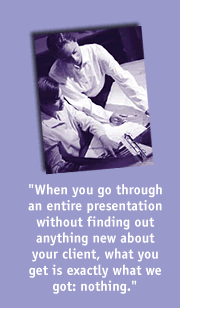
It's Not What You Say, But What You Ask
| Продажи | ||||
| Sales.com | ||||
| Making... | ||||
by Stephen E. Heiman, Diane Sanchez with Tad Tuleja
Years ago, when we had just started our business, we were asked to give a presentation to a large pharmaceutical company. There was good potential revenue involved, so we were there bright and early, raring to go. When we walked into the presentation room, we found a group of eight executives, only half of whom we had met, waiting for us to begin. The vice president of sales, who had invited us to make the presentation, introduced us to the group and then said, "OK, why don't you tell us what you do."
 With
the invitation to "hit it," we launched into the greatest product spiel
of our careers. For twenty-five minutes they sat enraptured as we described
all of our programs in infinite detail, explained how every one of them
was perfect for their type of business, and gave them a slide show that
would have made Hollywood envious. And what was the result of this world-class
performance? Not only did we not make the sale, but we weren't even invited
back for a second round. The reason was that we made at least two major
blunders.
With
the invitation to "hit it," we launched into the greatest product spiel
of our careers. For twenty-five minutes they sat enraptured as we described
all of our programs in infinite detail, explained how every one of them
was perfect for their type of business, and gave them a slide show that
would have made Hollywood envious. And what was the result of this world-class
performance? Not only did we not make the sale, but we weren't even invited
back for a second round. The reason was that we made at least two major
blunders.
First, we didn't clarify who we were talking to. The first thing we should have said was, "We've only met Don, Jane, Rebecca, and Arnie. Would the rest of you mind introducing yourselves and giving us some preliminary idea of your concerns?" Then we should have sat back and practiced the concept of Golden Silence while we found out why the eight of them were there - and, therefore, why we were there. By jumping headfirst into the presentation, we forced ourselves into a dog-and-pony show that may have had nothing to do with the individual interests of our listeners.
Second, we ignored what our audience was expecting from our service and concentrated solely on pitching our product. We figured at the time that this was an acceptable tactical approach because, after all, it was what the client had asked for. But going along with that seemingly reasonable request proved to be a big mistake. It forced us to into giving information and kept us trapped there throughout the whole sales call.
The outcome was disastrously one-sided. The pharmaceutical managers learned more than they ever wanted to know about our operation, but we learned nothing about them - nothing about their current needs, their problems, their reasons for calling us - that we hadn't known before we got there. When you go through an entire presentation without finding out anything new about the client, what you get is exactly what we got: nothing. We learned some valuable lessons from that experience:
You should never, absolutely never, give a dog-and-pony presentation to a group whose members you don't know. If there are surprise guests in your audience, find out before you start who they are and why they might want to listen to you.
Even if you're speaking to only one individual, never start with a product pitch. Find out early in each sales call interview what the current situation is regarding his expectations, and move to describing your product or service only when the customer is clearly ready for that information.
Even when you're convinced that he is ready for product information, test that assessment by asking questions: "Is this what we should be discussing?" or "Am I addressing your concerns?"
Finally, when you find yourself trapped into giving information, stop and ask for feedback from the customer. Even when you're invited to make a product pitch, involve the customer in the discussion and keep the presentation tied to the customer's expectations.
Adapted from The New Conceptual Selling Stephen E. Heiman, Diane Sanchez with Tad Tuleja (c) 1999 by Miller Heiman, Inc., All rights reserved with permission of Warner Books. Inc.